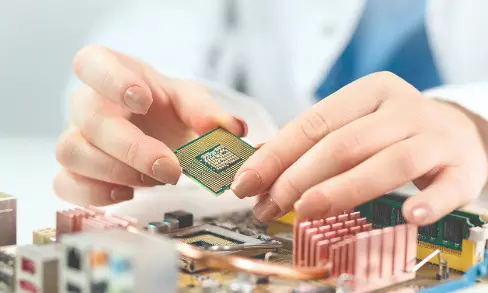Education & skilling hold key to India’s semiconductor future
The country’s semiconductor market is expected to cross USD 55 billion by 2026 and touch USD 100 billion by 2030

“Chips are digital diamonds. The world trusts India, the world believes in India and the world is ready to build the semiconductor future with India,” said PM Narendra Modi at the recently-held Semicon India 2025, a mega event designed to supercharge India’s semiconductor ecosystem. At the event, Union IT Minister Ashwini Vaishnaw handed over to the PM India’s first fully indigenous microprocessor, a semiconductor chip named Vikram 3201, developed by ISRO’s semiconductor laboratory.
Think about it. From the smartphones in our hands to electric cars, everything runs on these tiny chips. No wonder India is betting big. The country’s semiconductor market is expected to cross USD 55 billion by 2026 and touch USD 100 billion by 2030, powered by booming demand in smartphones, cars, 5G, and IoT with a solid push from government policies. And here’s the best part: this wave is projected to create one million new jobs by 2026, thanks to a mix of state support and private investments.
“Semiconductors are rightly being called ‘digital diamonds’ because they will form the backbone of our digital economy, and with this comes an enormous opportunity for employment. Industry estimates suggest that India’s semiconductor ecosystem could generate over a million direct and indirect jobs by 2030, across design, fabrication, testing, and supply-chain management,” said Shantanu Rooj, Founder and CEO, TeamLease Edtech.
The Semicon India programme, launched in 2021, is now showing serious results. On the state front, Gujarat has stolen an early lead, becoming the first to roll out a semiconductor policy. The Cabinet has also cleared semiconductor manufacturing units in Odisha, Punjab, and Andhra Pradesh, with a combined outlay of Rs 4,600 crore. And West Bengal is quickly carving out its own space in this high-tech race. At Semicon India 2025, when the first 33 ‘made-in-India’ chips were unveiled, four of them came from students and researchers in Bengal with teams from NIT Durgapur, IIEST Shibpur, and the University of Calcutta leading the charge.
Adding to that momentum, GlobalFoundries (GF), one of the world’s biggest semiconductor players, is setting up a fab-less design and testing centre at Kolkata Power Centre, with future plans to expand into fabrication. Following its footsteps, another US-based giant, Santech Global Inc, has also shown keen interest in West Bengal.
Prof Ankush Bag, Associate Professor, Dept. of Electronics and Electrical Engineering, IIT Guwahati, said under Indian Semiconductor Mission (ISM), there has been a tremendous interest, investment and initiatives for fabrication and packaging of electronic system to complete the semiconductor ecosystem in the country starting from materials and devices to circuits and systems. “Now in this manufacturing units of semiconductor systems, along with previously mentioned electronics engineering domain UG or PG students, there will be ample opportunities for science background students particularly from physics, chemistry as well as mechanical, chemical engineering students. Not only UG or PG students, there will be a lot of scope for diploma and ITI candidates for these hands-on skill-oriented jobs. Considering all these factors, this is perhaps the best time for the aspiring young minds to acquire domain knowledge in semiconductors or allied areas and prepare themselves with appropriate skills. Apart from these opportunities, there will also be a surge from research and development sections from both fabless and manufacturing units where highly skilled PG or PhD students shall have a lot of scope to contribute,” he said.
The semiconductor industry opens doors to a huge range of career paths. You could be a chip design engineer, process engineer, equipment engineer, test engineer, or product manager, each role critical in bringing these tiny but powerful devices to life. Beyond that, there are exciting opportunities in materials science, fabrication technology, automation, quality control, as well as the business side with sales, supply chain, and technical marketing. And as technologies like AI, 5G, and electric vehicles take off, the demand is only rising for experts in VLSI design, embedded systems, semiconductor physics, and advanced packaging. According to Dr Nipun Sharma, CEO, TeamLease Degree Apprenticeship, it is estimated that by 2027, there would be about 300,000 - 350,000 direct and indirect employment opportunities that will span Chip Design, Fabrication, ATMP (Assembly, Testing, Marking, and Packaging), Industrial Safety, as well as Supply Chain Management. Each of these areas demands a highly skilled workforce, making talent development a national priority. “By combining robust education reforms, practical training, and industry collaboration, India can not only meet the workforce needs of this sunrise sector but also position itself as a global leader in semiconductor innovation,” said Dr Sharma.
“The semiconductor industry is witnessing rapid global growth, driven by the rising demand for microchips and integrated circuits that power a wide range of modern technologies from consumer electronics and automotive systems to telecommunications and healthcare devices. This expanding market is creating diverse career opportunities in areas such as semiconductor design, manufacturing, quality testing, and research and development,” said Sardar Simarpreet Singh, Director, JIS Group.
Rooj of TeamLease Edtech believes to truly shine in this sector, education must keep pace. According to him, India needs a deep bench of VLSI designers, chip architects, embedded systems engineers, and materials scientists, roles that require specialised higher education. “At the same time, vocational skilling and certification pathways will be essential to build the technician and operator workforce that modern fabs depend on. In my view, India must create a layered approach: rigorous academic programmes at the top, supported by large-scale skilling and apprenticeships at the base. This is where employability lies - equipping young people not only with degrees but with the applied skills that industry demands. If done well, semiconductors could transform both our technological sovereignty and our job landscape,” he said.



